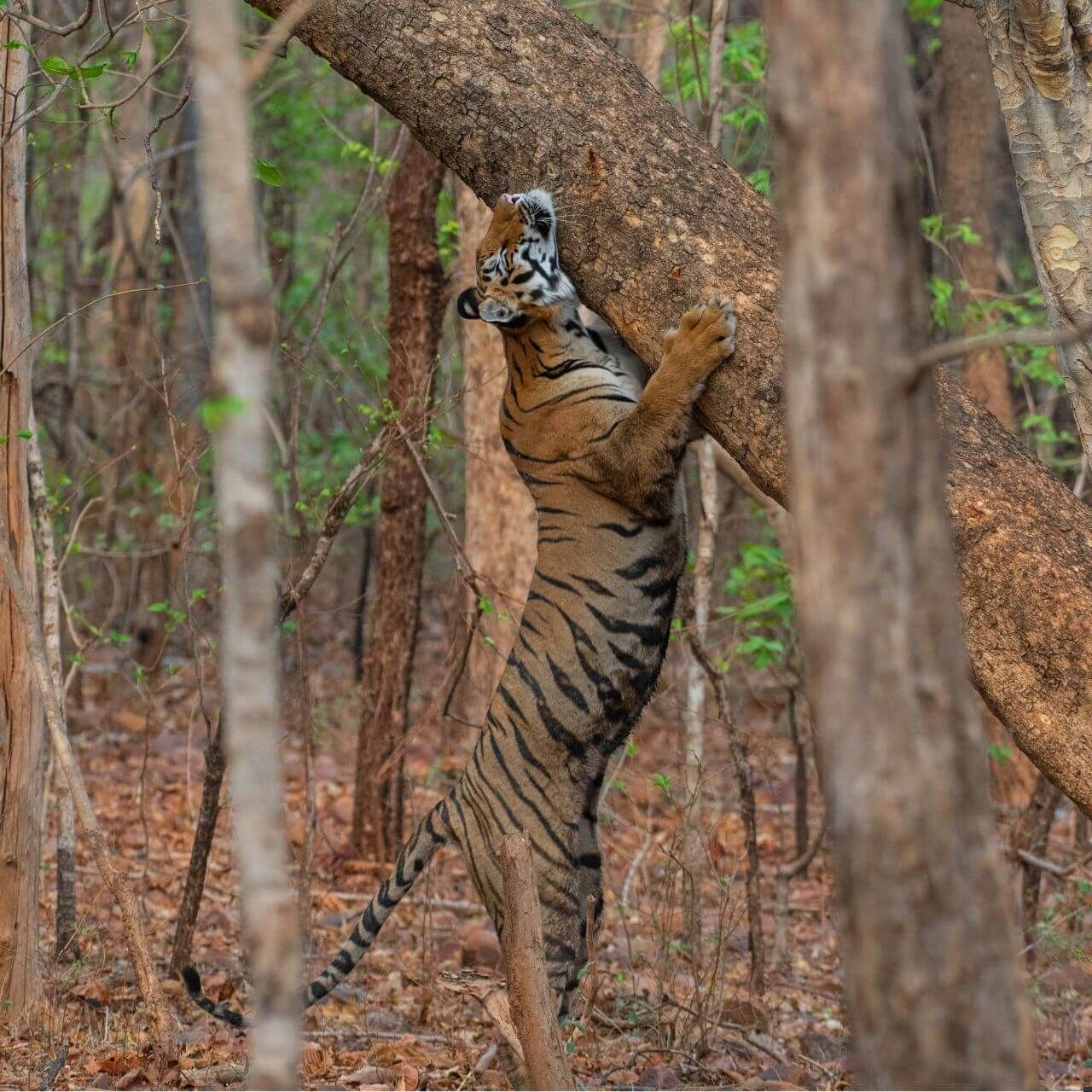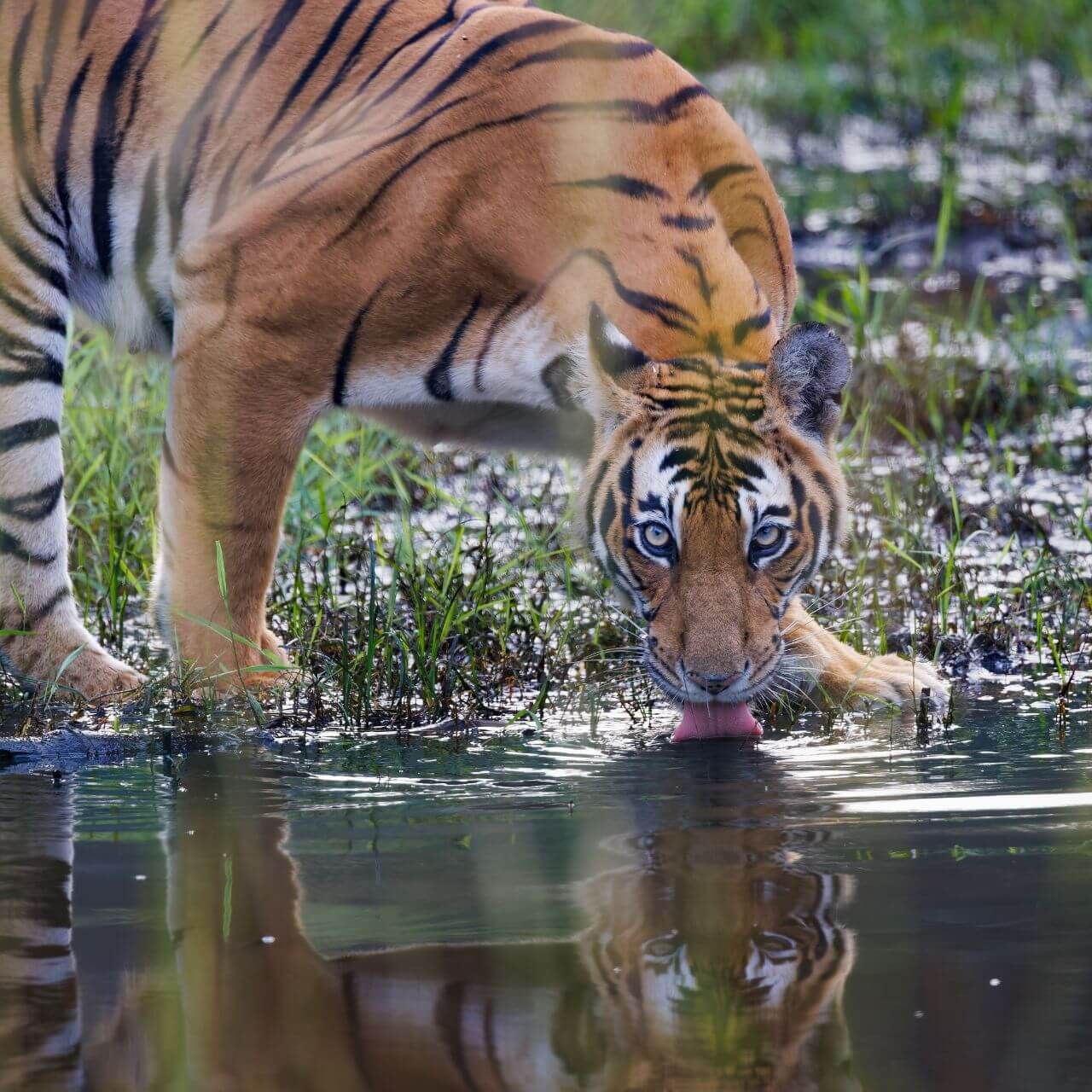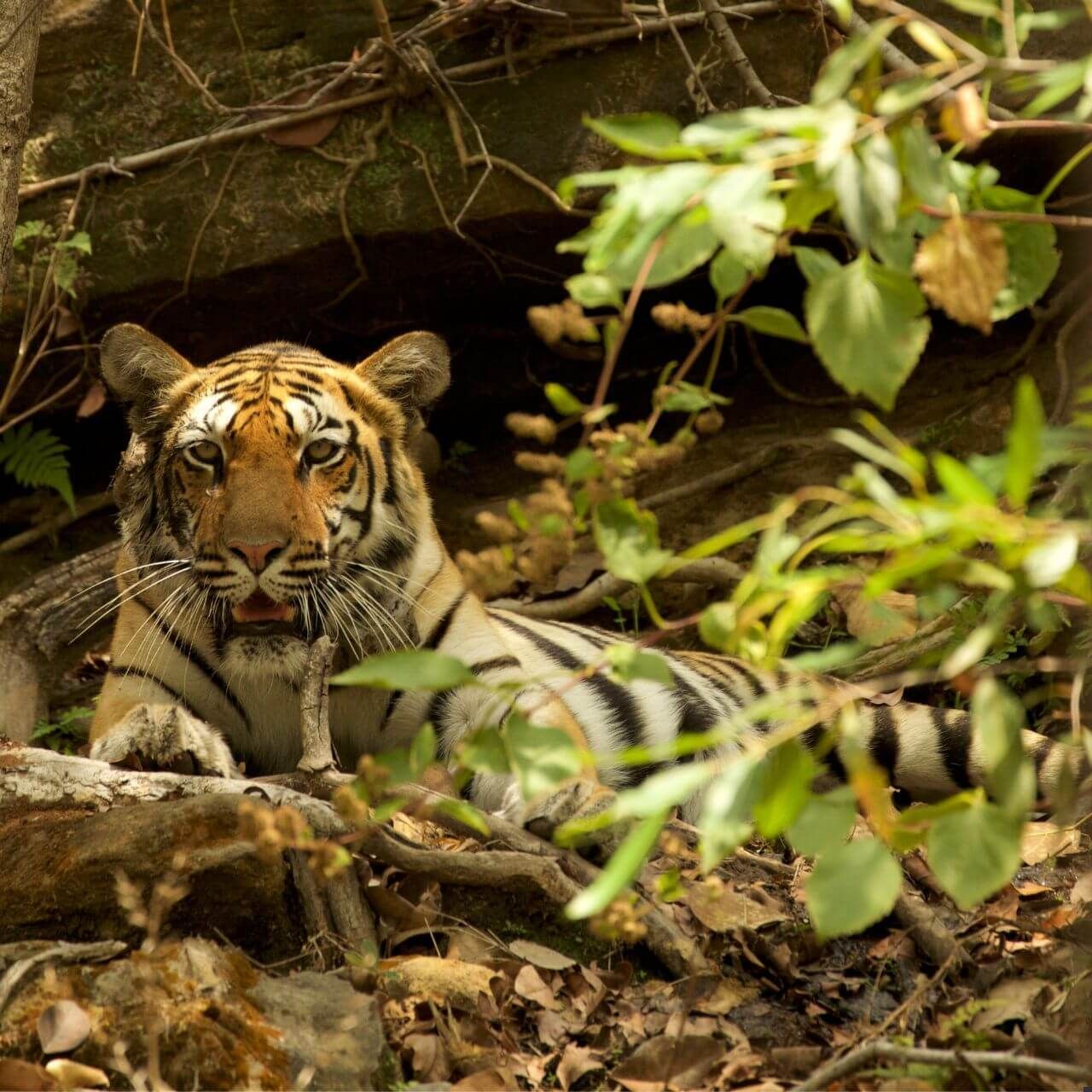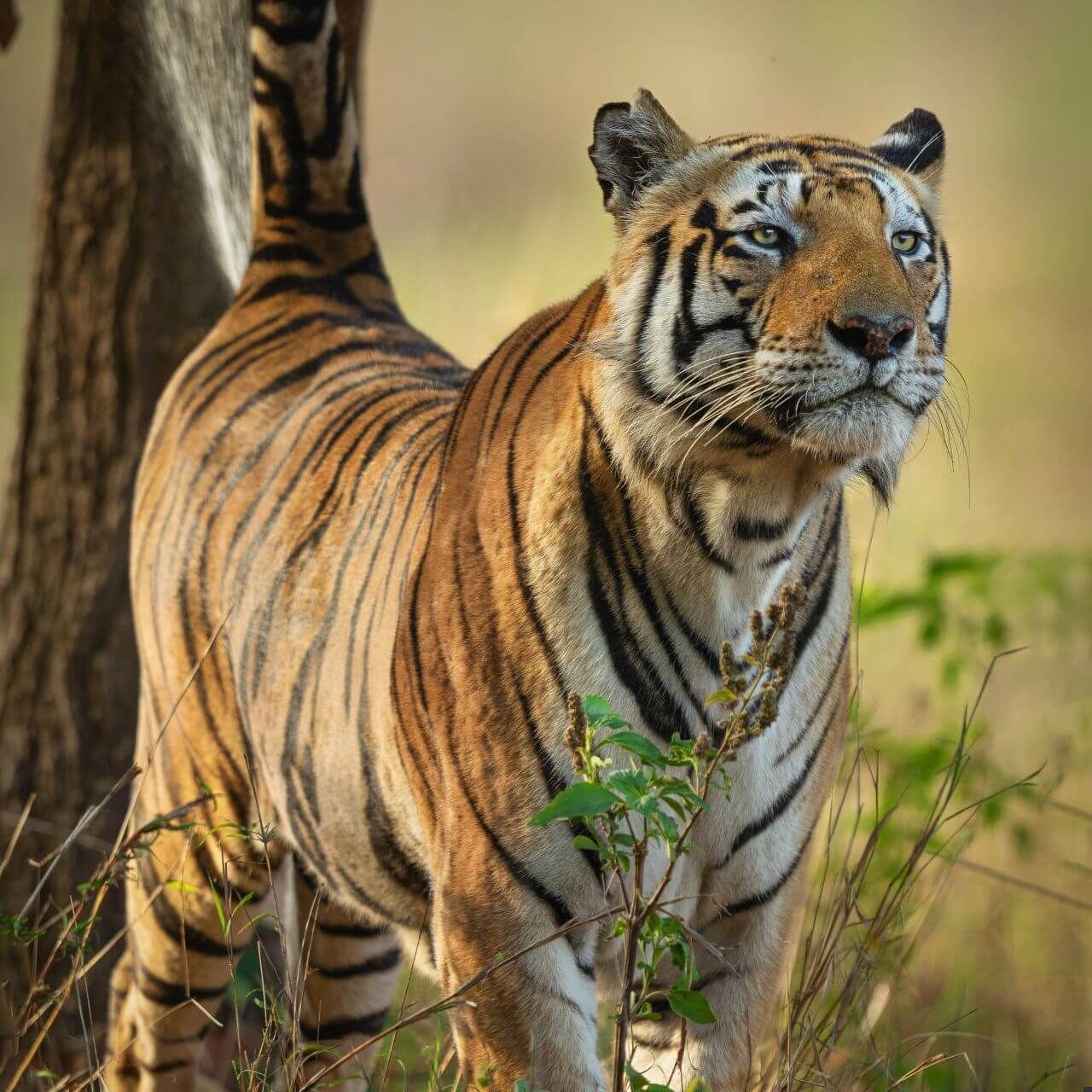Tigers

Let's Learn About Tigers
Word of the Week
Disruptive Coloration
Disruptive coloration is a type of camouflage that breaks up (disrupts) the outline of an animal's body. It makes it challenging to tell where the animal starts and ends.
Tigers, zebras, and leopards use disruptive coloration.
Fast Facts

Where do tigers live?
Tigers live in Asia and on the nearby island of Sumatra.
Most tigers are found in forests. Sumatran tigers like in warm, tropical rainforests, while Amur tigers live in cold, evergreen forests. They also live in mangrove swamps, savannas, and grasslands.
What do tigers eat?
Tigers are carnivores.
They are apex predators, meaning they are at the top of the food chain, they have no natural predators. They mainly eat large, hoofed animals like deer, bovine, and wild boar. They also eat ground birds and other medium to large animals.


What traits do tigers have?
Tigers have main unique and well-designed traits, such as...
- An orange coat with black stripes.
- Long, sharp claws and teeth.
- Solitary and territorial behaviors.
- A powerful sense of vision and hearing.
How many tigers are there?
Scientists currently identify one species of tiger with two subspecies. However, there has been debate about how many subspecies of tigers exist.
Regardless, tigers are considered to be endangered. As of 2023, the Global Tiger Forum estimated 5,660 existed in the wild. Read the Conservation Corner below to learn more about how scientists are working to protect tigers.

Species Spotlight
Amur Tiger
Formerly P. t. tigris
Have you heard of an Amur tiger? How about a Siberian tiger? Well, they are the same animal. The Siberian tiger was named after the region of Asia, Siberia, where it lived. Since then, their range has shrunk. Today, they live mostly in the Amur River Valley, so scientists changed their name.
Amur tigers are the largest of the tigers and all big cats. Large males weigh more than 600 lbs. That is three times heavier than an average adult man! Their large size is a helpful adaptation in the climate where they live.
Amur tigers live in cold, evergreen forests that are covered in snow for more than half the year. Their large bodies store plenty of fat, which keeps them warm. Storing fat also helps them survive harsh winters when food is less available. Their fur is also longer and thicker than other tigers that live in warmer areas.
Though their fur is longer, they still have an orange coat with black stripes to stay hidden while they ambush prey. Amur tigers feed heavily on deer and wild boar. They use wide paw pads to stay atop of soft snow while searching for prey and patrolling their territory. In some areas, Amur tiger populations have grown. They have spread out in search of new territories, sometimes near humans. Tigers that live close to people are often hunted out of fear or revenge for killing goats and sheep. Learn about how scientists are protecting tigers in the Conservation Corner.
BRAIN BLAST
Amur tigers live in cold climates while Sumatran tigers live in warm, tropical climates. Research both species and make a Venn diagram to identify their similarities and differences.
Conservation Corner
How Are Scientists Protecting Tigers?
In a 2004 poll from Animal Planet, tigers were named the world’s favorite animal. However, even with fame, tigers are still endangered. Scientists estimate there are fewer than 6,000 tigers in the wild. Their main threats are poaching, habitat loss, and loss of prey. Many organizations currently work to protect tigers. Let’s see how.
Research
The more we know about tigers, the easier it is to protect them. Scientists look for answers to questions about tiger behavior, such as...
• What part of the forest are tigers using?
• How big is a tiger’s territory?
• What prey items are most important for tigers?
Answering these questions helps us identify the best ways to protect their habitat and prey populations. Scientists use tracking collars and camera traps to gather information.
Reduce Retaliatory Hunting
Retaliatory hunting occurs when tigers prey on goats, sheep, or other domestic animals, and are hunted for revenge or to protect other animals. Scientists work with local communities to create tiger-proof enclosures and encourage them to keep pets inside. Fewer tigers are killed when domestic animals are protected.
Reduce Poaching
Other than retaliatory hunting, tigers are also killed for their skin, teeth, claws, and other trophies. Sometimes adult females are killed so poachers can take and sell their cubs. The sale of tigers and tiger parts is common, even though it is illegal in every country. Scientists work with governments to find new ways to track and stop the sale of tigers and tiger parts.
Tigers live in several countries, which is one of the greatest challenges to protecting them. Each country has the ability to make its own laws and environmental protections, and they do not always agree! Better communication and teamwork among governments and conservation groups is the key to saving tigers.
Tall Tales of Tigers
Determine if each statement about tigers is true or false.
Learn More!
*Please note: This video describes old information regarding tiger subspecies*
*Please note: This video shows a tiger catching and killing a deer*
Glossary
Adaptation
The process by which a species becomes more fit for its environment over the course of several generations. It is a result of natural selection.
Ambush
Sneak attack.
Apex Predator
The animal at the top of its food chain; it has no natural predators.
Bovine
A group of hoofed mammals including cows and their relatives.
Camouflage
The ability for an organism to blend into its surroundings usually to hide from prey or predators.
Carnivore
An animal that eats other animals.
Competition
An interaction between organisms where both are working to obtain the same resource.
Conservation
The preservation of something.
Disruptive Coloration
[Camouflage] When an animal's colors or patterns breakup the outline of its body making it harder for a predator to spot them.
Endangered
Referring to an organism that is threatened with extinction.
Feline
Referring to members of the cat family.
Flehmen Response
A smelling behavior used by felines, equine, and other mammals to detect pheromones and other chemicals, often for breeding purposes.
Habitat
The type of environment where a plant or animal lives.
Habitat Loss
When habitats are destroyed and changed into human-managed land such as farms or cities.
Human-Wildlife Conflict
Occurs when humans and wildlife live in close proximity and negatively impact each other.
Poaching
The illegal act of hunting or capturing an animal.
Predator
An animal that hunts other animals for food.
Prey
An animal that is hunted and eaten by another animal.
Range
The geographic location where an animal lives.
Solitary
To live alone.
Species
A closely related group of animals with similar characteristics that are capable of reproducing (example: tigers).
Subspecies
A group of animals within a species that are genetically different from other groups in the same species (example: Bangel tiger, Sumatran tiger, etc.).
Territorial
Referring to an animal that defends an area (its territory) from other members of its species.






